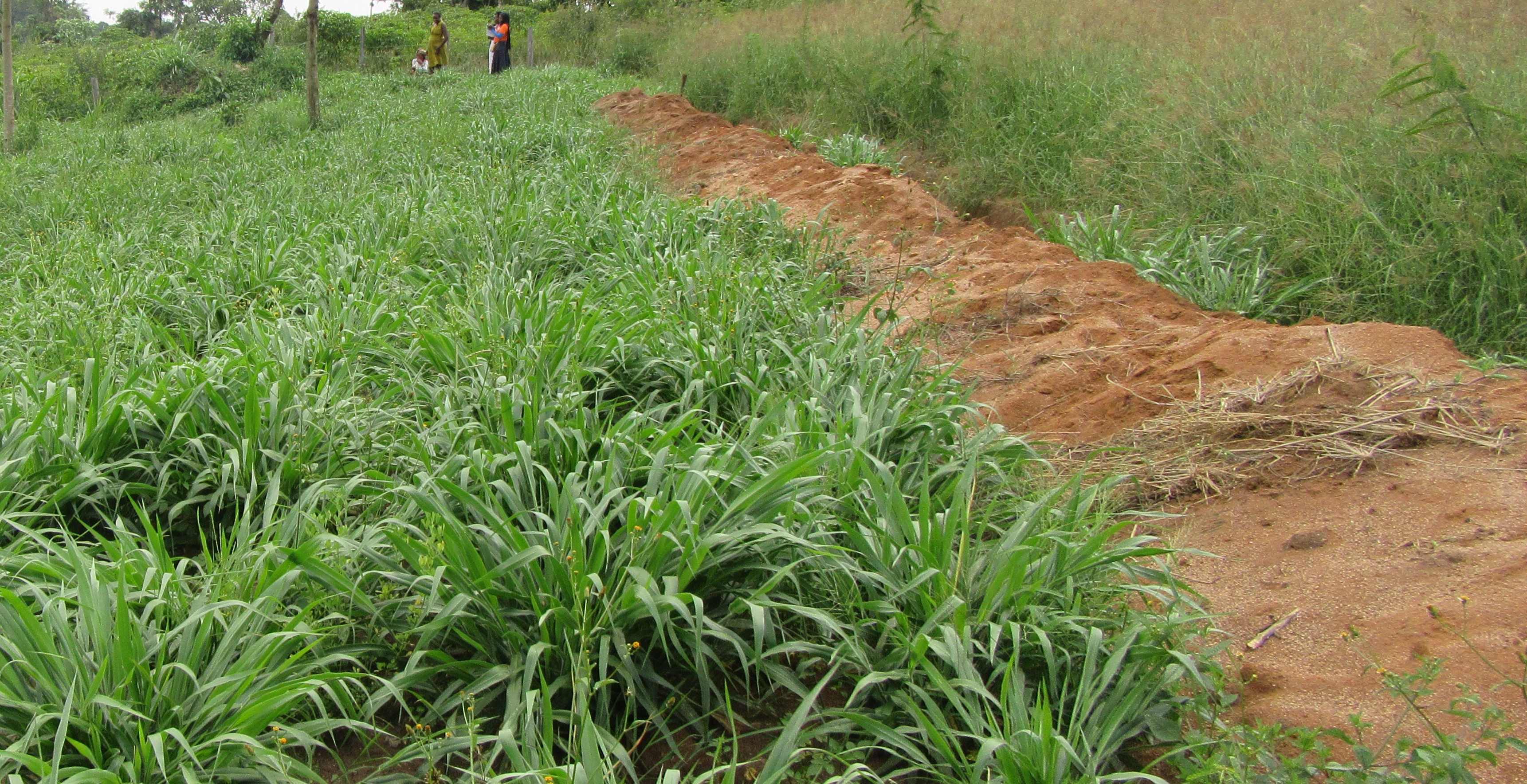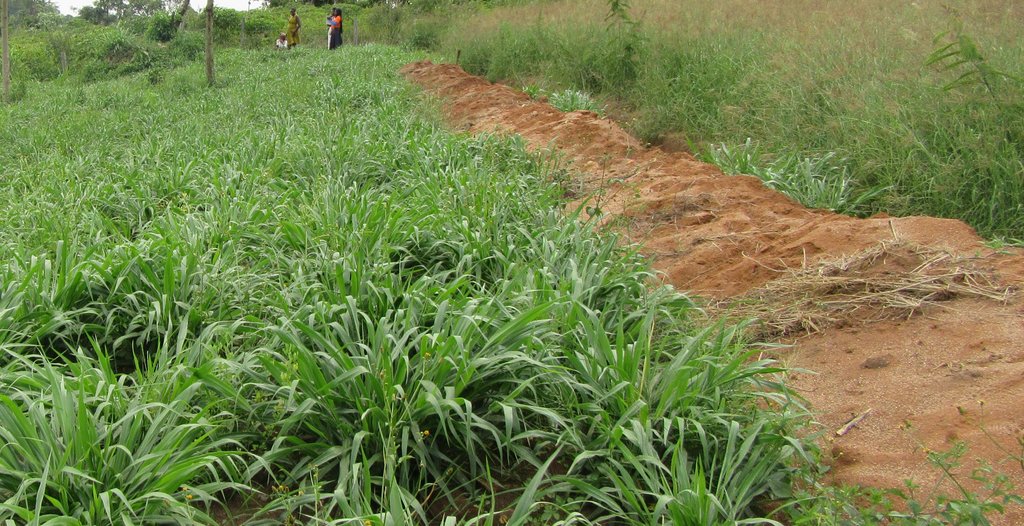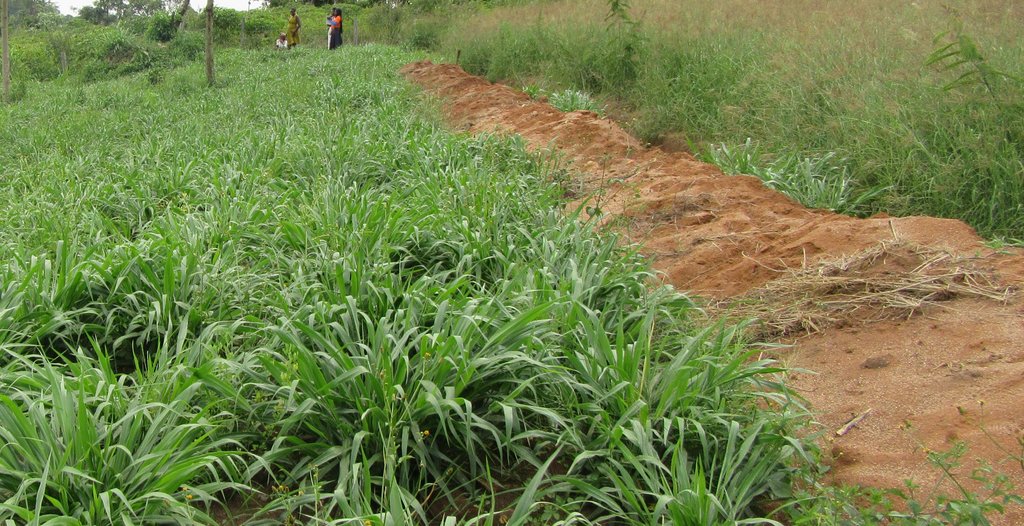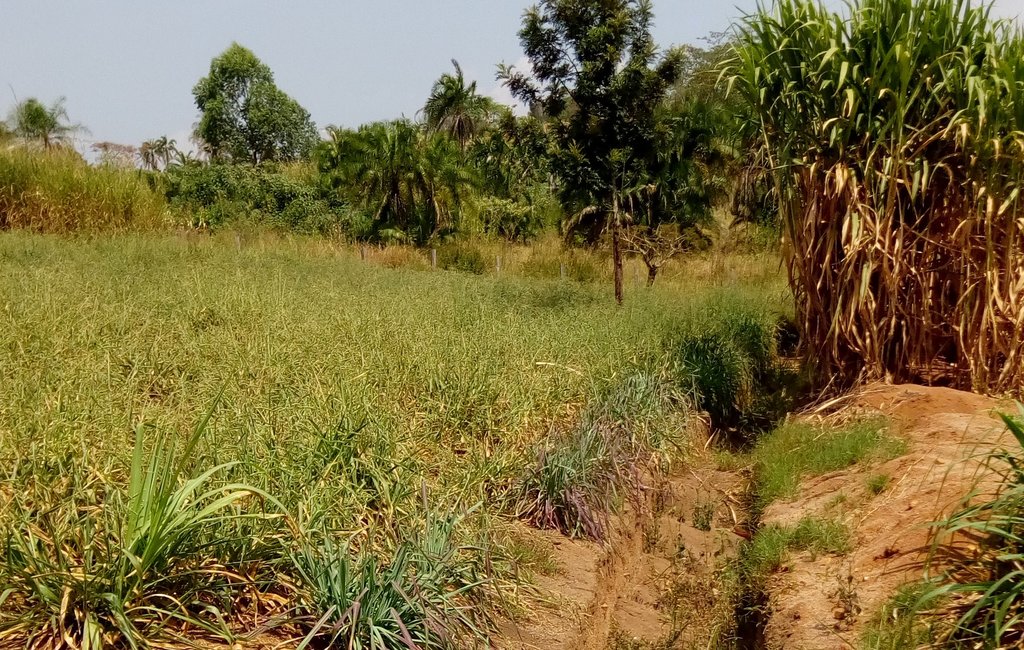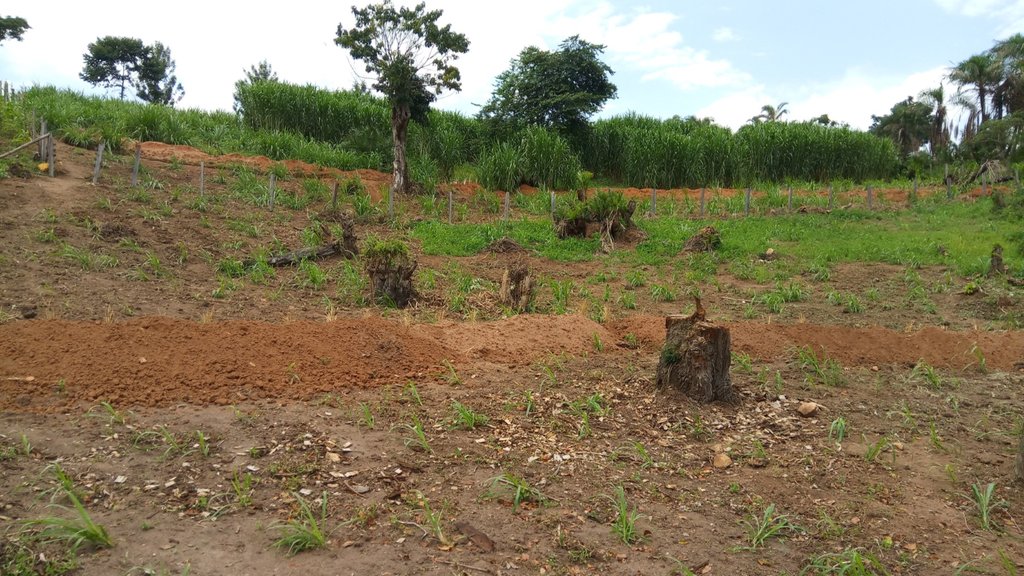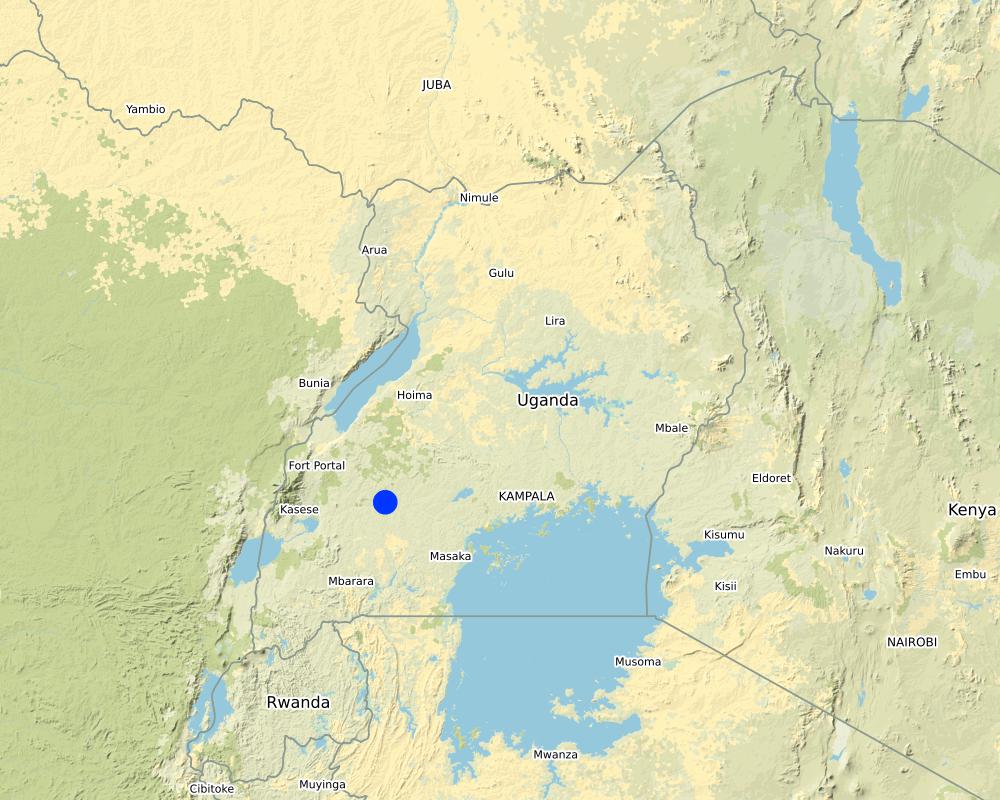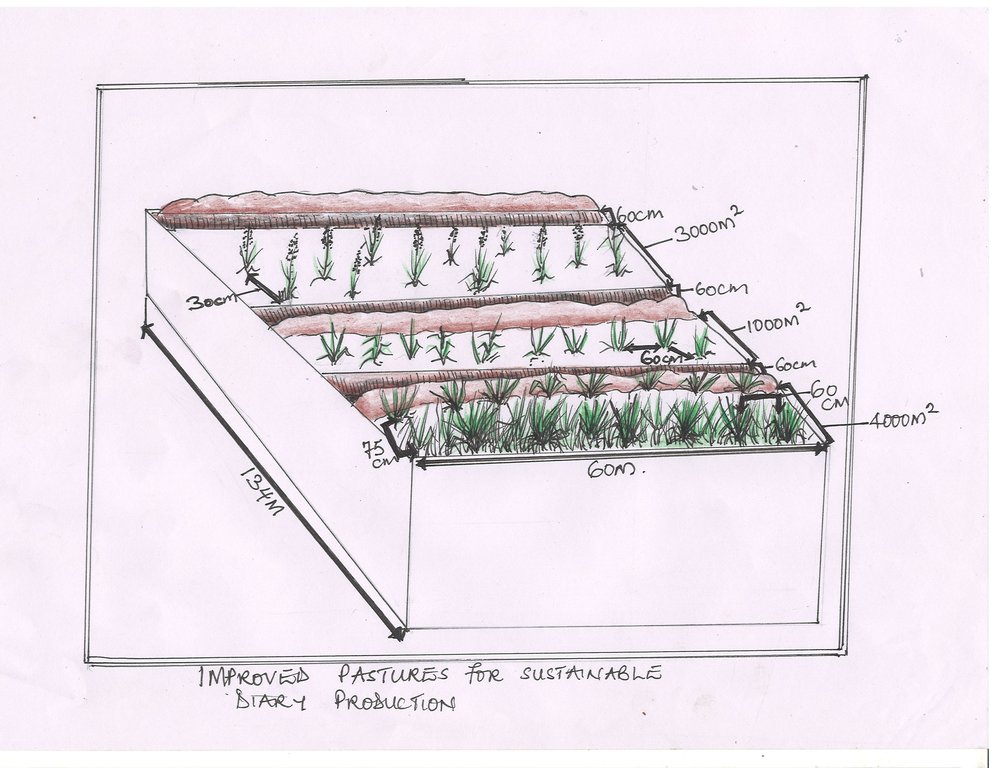Growing Improved Pastures for Sustainable Dairy Production [អ៊ូហ្គង់ដា]
- ការបង្កើត៖
- បច្ចុប្បន្នភាព
- អ្នកចងក្រង៖ Jalia Namakula
- អ្នកកែសម្រួល៖ Kamugisha Rick Nelson
- អ្នកត្រួតពិនិត្យច្រើនទៀត៖ Nicole Harari, Udo Höggel
Ebinyansi byokurisa ente zamate
technologies_3362 - អ៊ូហ្គង់ដា
ពិនិត្យមើលគ្រប់ផ្នែក
ពង្រីកមើលទាំងអស់ បង្រួមទាំងអស់1. ព័ត៌មានទូទៅ
1.2 ព័ត៌មានលម្អិតពីបុគ្គលសំខាន់ៗ និងស្ថាប័នដែលចូលរួមក្នុងការវាយតម្លៃ និងចងក្រងឯកសារនៃបច្ចេកទេស
បុគ្គលសំខាន់ម្នាក់ (ច្រើននាក់)
អ្នកប្រើប្រាស់ដី:
Mugisha Robert
Diary for Life
Kyegeggwa District
អ៊ូហ្គង់ដា
ឈ្មោះគម្រោងដែលបានចងក្រងឯកសារ/ វាយតម្លៃលើបច្ចេកទេស (បើទាក់ទង)
Scaling-up SLM practices by smallholder farmers (IFAD)ឈ្មោះអង្គភាពមួយ (ច្រើន) ដែលបានចងក្រងឯកសារ/ វាយតម្លៃបច្ចេកទេស (បើទាក់ទង)
National Agricultural Research Organisation (NARO) - អ៊ូហ្គង់ដា1.3 លក្ខខណ្ឌទាក់ទងទៅនឹងការប្រើប្រាស់ទិន្នន័យដែលបានចងក្រងតាមរយៈ វ៉ូខេត
តើពេលណាដែលទិន្នន័យបានចងក្រង (នៅទីវាល)?
17/10/2018
អ្នកចងក្រង និង(បុគ្គលសំខាន់ៗ)យល់ព្រមទទួលយកនូវលក្ខខណ្ឌនានាទាក់ទងទៅនឹងការប្រើប្រាស់ទិន្នន័យដែលបានចងក្រងតាមរយៈវ៉ូខេត:
បាទ/ចា៎
1.4 សេចក្តីប្រកាសស្តីពីចីរភាពនៃការពណ៌នាពីបច្ចេកទេស
តើបច្ចេកទេសដែលបានពណ៌នានេះមានបញ្ហាដែលផ្តោតលើការធ្លាក់ចុះគុណភាពដី, បើដូច្នេះវាមិនអាចត្រូវបានប្រកាសថាជាបច្ចេកទេសនៃការគ្រប់គ្រងប្រកបដោយចីរភាពទេ?
ទេ
មតិយោបល់:
Pastures act as fallows therefore they improve soil quality over time
2. ការពណ៌នាពីបច្ចេកទេស SLM
2.1 ការពណ៌នាដោយសង្ខេបពីបច្ចេកទេស
និយមន័យបច្ចេកទេស:
Growing Improved Pastures (chloris gayana, brachiaria mulato and pernisetum purpurem) is a technology promoted among small, meduim scale farmers in Kyegegwa District, Western Uganda for sustainable dairy production, improved nutrition and sustainable land management.
2.2 ការពណ៌នាលម្អិតពីបច្ចេកទេស
ការពណ៌នា:
Improved pastures comprising of fast growing nutritious grasses or legumes are generally said to be more productive than the local native pastures, because they have higher protein, carbohydrate levels and are easy to digest.
The pastures on the farm documented are established on a 2 acre piece of land located on a gently sloping area of about 20% in Kyegegwa District which experiences an average annual rainfall of about 1200 mm. The field covers the entire landscape and is neighboured by a cassava plantation. Within the same field, contour trenches were established to separate one pasture field from the other, and to also prevent soil and nutrient loss within the field. Pastures planted include Chloris gayana (rhodes grass), Brachiaria mulato (signal grass) and Pennisetum (napier grass). All grasses are native to East Africa.
Each pasture type on each plot is planted as a pure stand; the Chloris field lies on a 3000 m2 plot size, the Brachiaria field lies on 1000 m2 plot size and the Pennisetum field lies on a 4000 m2 plot size.
-Chloris gayana was planted at a spacing of 30 cm inter row and broadcasted within the rows, the seeds were mixed with sand before they were broadcasted. Thereafter the seeds were covered lightly with soils to enable easy germination of the tiny seeds.
-Brachiaria mulato was planted at a spacing of 60X 60cm
-Napier was planted at 75x 60cm.
Prior to establishment of the pastures, the plots were cleared of the bush, ploughed twice and harrowed to make a fine seed bed before planting. Two tonnes of animal manure was added. The following equipment was used:
-Hand hoes
-3 slashers
-A spirit level for leveling the contour trenches
Planting material for all the grasses was provided by the Rwebitaba Zonal Agricultural Research and Development Institute (RwebiZARDI) in form of root tillers for Brachiaria, seeds for Chloris and cuttings for the Pennisetum grass.
Kyegegwa is one of the districts where conflicts between livestock keepers and crop farmers are increasing. This kind of pressure does not allow free range grazing any more. Therefore the pastures planted were not only to provide better quality and quantity feeds for the dairy project throughout the year but also to reduce on conflicts with neighbours. Chloris gayana yields between 20-27t DM/ha and was planted to provide hay. It is drought tolerant, has a high regeneration capacity, easy to digest and is rich in carbohydrates, while Bracharia mulato is also palatable and often used in a cut & carry system. Bracharia is easy to conserve as compared to other grasses and is rich in proteins. Napier grass was planted for its early maturity, regeneration capacity, especially during the rainy season and just like Brachiaria easy to makes silage. The improved pastures are suitable for both cut & carry and grazing and they are tolerant to drought therefore providing a sustainable feed base for the diary all year round. The pastures were also planted to act as a fallow, thereby also improving soil fertility.
Establishment costs were estimated to be at UGX 1,396,000 while maintenance costs were estimated to be at UGX 320,000 per annum. Improved pastures are advantageous because they provide more nutrients than local pastures; Chloris provides more carbohydrates whereas Brachiaria and Penisetum provide more protein. Pastures rehabilitate degraded land by acting as vegetation cover for longer periods hence reducing soil erosion and increasing soil fertility. They control broad leaved weeds and a small piece of land is used to cut and carry for stock. Improved pastures require fencing as well as improved management practices such as a good soil fertility plan.
2.3 រូបភាពនៃបច្ចេកទេស
2.4 វីដេអូនៃបច្ចេកទេស
ការពណ៌នាសង្ខេប:
Video showing improved pastures
កាលបរិច្ឆេទ:
17/10/2017
ទីតាំង:
Kamwenge District, South Western Uganda
ឈ្មោះអ្នកថតវីឌីអូ:
Jalia Namakula
2.5 ប្រទេស/តំបន់/ទីតាំងកន្លែង ដែលបច្ចេកទេសត្រូវបានអនុវត្ត និងបានគ្រប់ដណ្តប់ដោយការវាយតម្លៃនេះ
ប្រទេស:
អ៊ូហ្គង់ដា
តំបន់/រដ្ឋ/ខេត្ត:
Western Uganda
បញ្ជាក់បន្ថែមពីលក្ខណៈនៃទីតាំង:
Kamwenge Town Council
មតិយោបល់:
The practice was established in Kyegegwa town council, Kyegegwa District, Western Uganda.
Map
×2.6 កាលបរិច្ឆេទនៃការអនុវត្ត
បង្ហាញឆ្នាំនៃការចុះអនុវត្ត:
2016
2.7 ការណែនាំពីបច្ចេកទេស
សូមបញ្ជាក់តើបច្ចេកទេសត្រូវបានណែនាំឱ្យអនុវត្តដោយរបៀបណា:
- តាមរយៈគម្រោង / អន្តរាគមន៍ពីខាងក្រៅ
មតិយោបល់ (ប្រភេទនៃគម្រោង ។ល។):
The improved pastures were promoted by Rwebitaba ZARDI through the Kamwenge District Local government
3. ចំណាត់ថ្នាក់នៃបច្ចេកទេស SLM
3.1 គោលបំណងចម្បង (១ ឬច្រើន) នៃបច្ចេកទេសនេះ
- ធ្វើឱ្យប្រសើរឡើងនូវផលិតកម្ម
- កាត់បន្ថយ, បង្ការ, ស្តារឡើងវិញនូវការធ្លាក់ចុះគុណភាពដី
3.2 ប្រភេទដីប្រើប្រាស់មួយប្រភេទ (ច្រើនប្រភេទ) ដែលបានអនុវត្តបច្ចេកទេស

ដីដាំដំណាំ
- ដំណាំប្រចាំឆ្នាំ
ដំណាំចម្បង (ដំណាំកសិ-ឧស្សាហកម្ម និងដំណាំស្បៀង) :
Cassava, maize
មតិយោបល់:
The farm is neighboured by a cassava plantation and a maize field
ប្រសិនបើដីមានការប្រែប្រួលបន្ទាប់ពីការអនុវត្តបច្ចេកទេស សូមបញ្ជាក់ពីការប្រើប្រាស់ដីមុនពេលអនុវត្តន៍បច្ចេកទេស:
The field was previously used for maize cultivation
3.3 ព័ត៌មានបន្ថែមអំពីអ្នកប្រើប្រាស់ដី
ការផ្គត់ផ្គង់ទឹកនៅកន្លែងអនុវត្តបច្ចេកទេស:
- ទឹកភ្លៀង និងប្រព័ន្ធស្រោចស្រព
មតិយោបល់:
There is a wetland at the foot of the slopes where water is drawn and used to irrigate the pastures, in addition an irrigation system is being constructed to enable sustainable pasture production.
ចំនួនសារដែលដាំដំណាំក្នុងមួយឆ្នាំ:
- 2
សូមបញ្ជាក់:
Pastures are harvested twice a year
3.4 ក្រុម SLM ដែលបច្ចេកទេសស្ថិតនៅក្នុង
- កសិរុក្ខកម្ម (pastoralism) និងការគ្រប់គ្រងដីសម្រាប់ចិញ្ចឹមសត្វ
3.5 ការសាយភាយនៃបច្ចេកទេស
បញ្ជាក់ពីការសាយភាយនៃបច្ចេកទេស:
- ត្រូវបានផ្សព្វផ្សាយត្រឹមតំបន់មួយ
ប្រសិនបើបច្ចេកទេសត្រូវបានសាយភាយពាសពេញតំបន់ណាមួយ សូមកំណត់ទំហំផ្ទៃដីអនុវត្តន៍:
- < 0.1 គម2 (10 ហិកតា)
មតិយោបល់:
The field lies on 0.8 ha of land
3.6 វិធានការ SLM ដែលបញ្ចូលនូវបច្ចេកទេស

វិធានការរុក្ខជាតិ
- V2: ស្មៅនិងរុក្ខជាតិៗដែលដុះមានអាយុមិនលើសពី 2ឆ្នាំ
មតិយោបល់:
Improved pastures planted include Signal grass (Brachiaria mulato), Rhodes grass (Chloris gayana), and Napier grass (pernnisetum Purpurem)
3.7 កំណត់ប្រភេទនៃការធ្លាក់ចុះគុណភាពដីសំខាន់ៗដែលបច្ចេកទេសនេះបានដោះស្រាយ

ការហូរច្រោះដីដោយសារទឹក
- Wt: ការបាត់ដីស្រទាប់លើដោយការហូរច្រោះ

ការធ្លាក់ចុះសារធាតុគីមីក្នុងដី
- Cn: ការថយចុះជីជាតិ និងកាត់បន្ថយបរិមាណសារធាតុសរីរាង្គ (មិនកើតឡើងដោយការហូរច្រោះទេ)

ការធ្លាក់ចុះជីវសាស្ត្រនៃដី
- Bc: ការថយចុះនូវគម្របរុក្ខជាតិ
- Bl: ការបាត់បង់មីក្រូ និងម៉ាក្រូសរីរាង្គរបស់ដី
មតិយោបល់:
The pastures are a perennial crop that act as a soil cover for longer periods of time, preventing soil and nutrient loss therefore improving soil fertility and productivity
3.8 ការពារ កាត់បន្ថយ ឬស្តារឡើងវិញនៃការធ្លាក់ចុះគុណភាពដី
បញ្ជាក់ពីគោលដៅរបស់បច្ចេកទេស ដែលផ្តោតទៅការធ្លាក់ចុះគុណភាពដី:
- ការការពារការធ្លាក់ចុះគុណភាពដី
- ការជួសជុល/ ស្តារឡើងវិញនៃឱនភាពដីធ្ងន់ធ្ងរ
មតិយោបល់:
Pastures, because of their longivity, reduce soil erosion and therefore improve soil fertility
4. បច្ចេកទេសជាក់លាក់ សកម្មភាពអនុវត្ត ធាតុចូល និងថ្លៃដើម
4.1 គំនូសបច្ចេកទេសនៃបច្ចេកទេសនេះ
4.2 លក្ខណៈពិសេសនៃបច្ចេកទេស/ ពណ៌នាពីគំនូរបច្ចេកទេស
The technical drawing shows improved pastures established on 0.8 ha of land (8000 m2), planted with Brachiaria (planted on 1000 m2 plot size at a spacing of 60×60cm), Chloris guyana, planted on a 3000 m2 plot size at a spacing of 30cm inter row and seed broadcasted within the row. Napier grass planted on a 4000 m2 plot size at a spacing of 75×60cm, using plant cuttings. The pastures are planted in three different blocks with each block separated by a contour trench of 2 m width and 60 m length. The Brachiaria grows up to a height of 50 cm, Chloris to around 90 cm and Napier grass can grow up to a 2 m.
4.3 ព័ត៌មានទូទៅដែលពាក់ព័ន្ធនឹងការគណនាធាតុចូល និងថ្លៃដើម
កំណត់របៀបនៃការគណនាថ្លៃដើម និងធាតុចូល:
- ក្នុងតំបន់អនុវត្តបច្ចេកទេស
កំណត់ទំហំ និងឯកត្តាផ្ទៃដី:
2 acres
ផ្សេងៗ/ រូបិយប័ណ្ណជាតិ (បញ្ជាក់):
UGX
កំណត់អត្រាប្តូរប្រាក់ពីដុល្លាទៅរូបិយប័ណ្ណតំបន់ (បើទាក់ទង)៖ 1 ដុល្លារ =:
3800,0
កំណត់ថ្លៃឈ្នួលជាមធ្យមនៃការជួលកម្លាំងពលកម្មក្នុងមួយថ្ងៃ:
7000
4.4 សកម្មភាពបង្កើត
| សកម្មភាព | ប្រភេទវិធានការ | ពេលវេលា | |
|---|---|---|---|
| 1. | Slashing | ការគ្រប់គ្រង | Once |
| 2. | Ploughing | ក្សេត្រសាស្ត្រ | Once |
| 3. | Field Marking | ក្សេត្រសាស្ត្រ | Once |
| 4. | Planting | ក្សេត្រសាស្ត្រ | Once |
4.5 ថ្លៃដើម និងធាតុចូលដែលត្រូវការសម្រាប់ការបង្កើតបច្ចេកទេស
| បញ្ជាក់ពីធាតុចូល | ឯកតា | បរិមាណ | ថ្លៃដើមក្នុងមួយឯកតា | ថ្លៃធាតុចូលសរុប | % នៃថ្លៃដើមដែលចំណាយដោយអ្នកប្រើប្រាស់ដី | |
|---|---|---|---|---|---|---|
| កម្លាំងពលកម្ម | Slashing | day | 3,0 | 100000,0 | 300000,0 | 100,0 |
| កម្លាំងពលកម្ម | Ploughing | day | 3,0 | 120000,0 | 360000,0 | 100,0 |
| កម្លាំងពលកម្ម | Planting | day | 2,0 | 100000,0 | 200000,0 | 100,0 |
| កម្លាំងពលកម្ម | Excavating contour trenches | meter | 10000,0 | 100,0 | ||
| សម្ភារៈ | Slasher | piece | 3,0 | 7000,0 | 21000,0 | 100,0 |
| សម្ភារៈ | Hoes | piece | 3,0 | 10000,0 | 30000,0 | 100,0 |
| សម្ភារៈ | Chisel | piece | 1,0 | 10000,0 | 10000,0 | 100,0 |
| សម្ភារៈ | Spirit level | piece | 1,0 | 20000,0 | 20000,0 | 100,0 |
| សម្ភារៈដាំដុះ | Wheelbarrow | piece | 1,0 | 75000,0 | 75000,0 | 100,0 |
| សម្ភារៈដាំដុះ | Panga | piece | 3,0 | 10000,0 | 30000,0 | 100,0 |
| សម្ភារៈដាំដុះ | Brachiaria | bags | 5,0 | 50000,0 | 250000,0 | |
| សម្ភារៈដាំដុះ | Chloris gayana | kg | 1,0 | 100000,0 | 100000,0 | |
| សម្ភារៈដាំដុះ | Napier grass | piece | 10,0 | 50000,0 | 500000,0 | |
| ជី និងសារធាតុពុល | Manure | bag | 20,0 | 10000,0 | 200000,0 | 100,0 |
| ថ្លៃដើមសរុបក្នុងការបង្កើតបច្ចេកទេស | 2096000,0 | |||||
ប្រសិនបើអ្នកប្រើប្រាស់ដីមិនមានថ្លៃដើម 100% សូមបញ្ជាក់ថានរណាដែលចំណាយថ្លៃដើមដែលនៅសល់:
Labour and equipment costs were covered by the land user
មតិយោបល់:
Planting material was provided by the Town Council
4.6 សកម្មភាពថែទាំ
| សកម្មភាព | ប្រភេទវិធានការ | ពេលវេលា/ ភាពញឹកញាប់ | |
|---|---|---|---|
| 1. | Weeding | ក្សេត្រសាស្ត្រ | once a month |
| 2. | Pesticide application | ក្សេត្រសាស្ត្រ | once a month |
| 3. | Cutting | ការគ្រប់គ្រង | twice a month |
| 4. | Fertiliser application | ក្សេត្រសាស្ត្រ | twice annually |
4.7 កំណត់ថ្លៃដើមសម្រាប់ការថែទាំ/ សកម្មភាពរបស់បច្ចេកទេស (ក្នុងរយៈពេលមួយឆ្នាំ)
| បញ្ជាក់ពីធាតុចូល | ឯកតា | បរិមាណ | ថ្លៃដើមក្នុងមួយឯកតា | ថ្លៃធាតុចូលសរុប | % នៃថ្លៃដើមដែលចំណាយដោយអ្នកប្រើប្រាស់ដី | |
|---|---|---|---|---|---|---|
| កម្លាំងពលកម្ម | Weeding | piece | 1,5 | 80000,0 | 120000,0 | 100,0 |
| កម្លាំងពលកម្ម | Spraying | piece | 1,5 | 10000,0 | 15000,0 | 100,0 |
| កម្លាំងពលកម្ម | Cutting | piece | 1,5 | 10000,0 | 15000,0 | 100,0 |
| សម្ភារៈ | Panga | piece | 3,0 | 10000,0 | 30000,0 | 100,0 |
| សម្ភារៈ | Knapsack | piece | 1,0 | 120000,0 | 120000,0 | 100,0 |
| ជី និងសារធាតុពុល | Pesticides | liter | 1,0 | 20000,0 | 20000,0 | 100,0 |
| ថ្លៃដើមសរុបសម្រាប់ការថែទាំដំណាំតាមបច្ចេកទេស | 320000,0 | |||||
ប្រសិនបើអ្នកប្រើប្រាស់ដីមិនមានថ្លៃដើម 100% សូមបញ្ជាក់ថានរណាដែលចំណាយថ្លៃដើមដែលនៅសល់:
The seed and planting material were given by the RwebitabaZARDI through the Kyegegwa Town Council
មតិយោបល់:
Establishment of the improved pastures was done in partnership with the RwebiZARDI and Kyegegwa town council. The Agreement was for the development partners to provide seed and the beneficiary to incur establishment and maintenance costs .
4.8 កត្តាសំខាន់បំផុតដែលមានឥទ្ធិពលដល់ការចំណាយ
ពណ៌នាពីកត្តាប៉ះពាល់ចម្បងៗទៅលើថ្លៃដើម:
Availability of labour
5. លក្ខណៈបរិស្ថានធម្មជាតិ និងមនុស្ស
5.1 អាកាសធាតុ
បរិមាណទឹកភ្លៀងប្រចាំឆ្នាំ
- < 250 មម
- 251-500 មម
- 501-750 មម
- 751-1,000 មម
- 1,001-1,500 មម
- 1,501-2,000 មម
- 2,001-3,000 មម
- 3,001-4,000 មម
- > 4,000 មម
កំណត់បរិមាណទឹកភ្លៀង (បើដឹង) ជា មីលីម៉ែត្រ:
1200,00
លក្ខណៈពិសេស/ មតិយោបល់លើរដូវភ្លៀង:
Rainfall onsets in March-June
Second season starts in August- December
តំបន់កសិអាកាសធាតុ
- សើម
Uganda has a tropical climate
5.2 សណ្ឋានដី
ជម្រាលជាមធ្យម:
- រាបស្មើ (0-2%)
- ជម្រាលតិចតួច (3-5%)
- មធ្យម (6-10%)
- ជម្រាលខ្ពស់បន្តិច (11-15%)
- ទីទួល (16-30%)
- ទីទួលចោត (31-60%)
- ទីទួលចោតខ្លាំង (>60%)
ទម្រង់ដី:
- ខ្ពង់រាប
- កំពូលភ្នំ
- ជម្រាលភ្នំ
- ជម្រាលទួល
- ជម្រាលជើងភ្នំ
- បាតជ្រលងភ្នំ
តំបន់តាមរយៈកម្ពស់ :
- 0-100 ម
- 101-500 ម
- 501-1,000 ម
- 1,001-1,500 ម
- 1,501-2,000 ម
- 2,001-2,500 ម
- 2,501-3,000 ម
- 3,001-4,000 ម
- > 4,000 ម
5.3 ដី
ជម្រៅដីជាមធ្យម:
- រាក់ខ្លាំង (0-20 សម)
- រាក់ (21-50 សម)
- មធ្យម (51-80 សម)
- ជ្រៅ (81-120 សម)
- ជ្រៅខ្លាំង (> 120 សម)
វាយនភាពដី (ស្រទាប់លើ):
- មធ្យម (ល្បាយ, ល្បាប់)
វាយនភាពដី (> 20 សម ស្រទាប់ក្នុង):
- មធ្យម (ល្បាយ, ល្បាប់)
សារធាតុសរីរាង្គនៅស្រទាប់ដីខាងលើ:
- មធ្យម (1-3%)
5.4 ទឹកដែលអាចទាញមកប្រើប្រាស់បាន និងគុណភាពទឹក
នីវ៉ូទឹកក្រោមដី:
< 5 ម
ទឹកលើដីដែលអាចទាញយកប្រើប្រាស់បាន:
ល្អ
គុណភាពទឹក (មិនបានធ្វើប្រត្តិកម្ម):
ទឹកសម្រាប់តែការធ្វើកសិកម្ម (ស្រោចស្រព)
តើមានបញ្ហាភាពទឹកប្រៃហូរចូលមកដែរឬទេ?
ទេ
តើទឹកជំនន់កំពុងកើតមាននៅតំបន់នេះដែររឺទេ?
បាទ/ចា៎
ភាពទៀងទាត់:
ម្តងម្កាល
មតិយោបល់ និងលក្ខណៈពិសេសផ្សេងៗទៀតលើគុណភាព និងបរិមាណទឹក :
The water table is high
5.5 ជីវៈចម្រុះ
ភាពសម្បូរបែបនៃប្រភេទ:
- ទាប
ភាពសម្បូរបែបនៃទីជម្រក:
- ទាប
មតិយោបល់ និងលក្ខណៈពិសេសផ្សេងទៀតលើជីវចម្រុះ:
The field has only grasses
5.6 លក្ខណៈនៃអ្នកប្រើប្រាស់ដីដែលអនុវត្តបច្ចេកទេស
នៅមួយកន្លែង ឬពនេចរ :
- នៅមួយកន្លែង
ទីផ្សារនៃប្រព័ន្ធផលិតកម្ម:
- ពាក់កណ្តាលពាណិជ្ជកម្ម (ផ្គត់ផ្គង់ខ្លួនឯង/ ពាណិជ្ជកម្ម
ចំណូលក្រៅកសិកម្ម:
- 10-50% នៃចំណូល
កម្រិតជីវភាព:
- មាន
ឯកជន ឬក្រុម:
- ធ្វើខ្លួនឯង/ គ្រួសារ
កម្រិតប្រើប្រាស់គ្រឿងយន្ត:
- គ្រឿងយន្ត/ ម៉ាស៊ីន
យេនឌ័រ:
- បុរស
អាយុរបស់អ្នកប្រើប្រាស់ដី:
- យុវវ័យ
សូមបញ្ជាក់ពីលក្ខណៈពាក់ព័ន្ធផ្សេងទៀតអំពីអ្នកប្រើប្រាស់ដី:
The farmer owns a general merchandise shop in Kyegegwa town
5.7 ទំហំផ្ទៃដីជាមធ្យមនៃដីផ្ទាល់ខ្លួន ឬជួលគេដែលបានអនុវត្តបច្ចេកទេស
- < 0.5 ហិកតា
- 0.5-1 ហិកតា
- 1-2 ហិកតា
- 2-5 ហិកតា
- 5-15 ហិកតា
- 15-50 ហិកតា
- 50-100 ហិកតា
- 100-500 ហិកតា
- 500-1,000 ហិកតា
- 1,000-10,000 ហិកតា
- > 10,000 ហិកតា
តើផ្ទៃដីនេះចាត់ទុកជាទំហំកម្រិតណាដែរ ខ្នាតតូច មធ្យម ឬខ្នាតធំ (ធៀបនឹងបរិបទតំបន់)?
- ខ្នាតតូច
មតិយោបល់:
He owns 4 acres of land but in Kamwenge District average land holding is 10 acres
5.8 ភាពជាម្ចាស់ដី កម្មសិទ្ធប្រើប្រាស់ដី និងកម្មសិទ្ធប្រើប្រាស់ទឹក
ភាពជាម្ចាស់ដី:
- ឯកជន មានកម្មសិទ្ធ
កម្មសិទ្ធិប្រើប្រាស់ដី:
- ឯកជន
កម្មសិទ្ធប្រើប្រាស់ទឹក:
- ឯកជន
មតិយោបល់:
A personal water reservoir was constructed
5.9 ការប្រើប្រាស់សេវាកម្ម និងហេដ្ឋារចនាសម្ព័ន្ធ
សុខភាព:
- មិនល្អ
- មធ្យម
- ល្អ
ការអប់រំ:
- មិនល្អ
- មធ្យម
- ល្អ
ជំនួយបច្ចេកទេស:
- មិនល្អ
- មធ្យម
- ល្អ
ការងារ (ឧ. ការងារក្រៅកសិដ្ឋាន):
- មិនល្អ
- មធ្យម
- ល្អ
ទីផ្សារ:
- មិនល្អ
- មធ្យម
- ល្អ
ថាមពល:
- មិនល្អ
- មធ្យម
- ល្អ
ផ្លូវ និងការដឹកជញ្ជូន:
- មិនល្អ
- មធ្យម
- ល្អ
ទឹកផឹក និងអនាម័យ:
- មិនល្អ
- មធ្យម
- ល្អ
សេវាកម្មហិរញ្ញវត្ថុ:
- មិនល្អ
- មធ្យម
- ល្អ
6. ផលប៉ះពាល់ និងការសន្និដ្ឋាន
6.1 ផលប៉ះពាល់ក្នុងបរិវេណអនុវត្តបច្ចេកទេសដែលកើតមាន
ផលប៉ះពាល់លើសេដ្ឋកិច្ចសង្គម
ផលិតផល
ផលិតកម្មចំណីសត្វ
មតិយោបល់/ ការបញ្ជាក់:
The different pastures are planted for sustainable provision of fodder throughout the year, hence stress for feed during drought period has reduced
គុណភាពចំណីសត្វ
មតិយោបល់/ ការបញ្ជាក់:
The livestock is now feeding on highly nutritious fodder hence milk production has increased throughout the year
ចំណូល និងថ្លៃដើម
ចំណូលក្នុងកសិដ្ឋាន
គុណភាពមុន SLM:
4,500,000
គុណភាពក្រោយ SLM:
7,500,000
មតិយោបល់/ ការបញ្ជាក់:
Before SLM,the land user was getting 15 litres of milk per day per cow at the peak of production but since increasing fodder production he is getting 25 liters of milk per day per cow (10 fresians) at the peak of production which happens in about 7 weeks into lactation period.
ផលប៉ះពាល់ទៅលើវប្បធម៌សង្គម
សន្តិសុខស្បៀង/ ភាពគ្រប់គ្រាន់ខ្លួនឯង
មតិយោបល់/ ការបញ្ជាក់:
The farmer's milk production has increased, he gets enough for commercial and home consumption
ការកាត់បន្ថយជម្លោះ
មតិយោបល់/ ការបញ្ជាក់:
Because he has his own improved pastures , conflict with the neighbours on cutting their grass has reduced
ផលប៉ះពាល់ទៅលើអេកូឡូស៊ី
ដី
សំណើមដី
មតិយោបល់/ ការបញ្ជាក់:
Pastures act as a soil cover therefore reducing on soil water loss
គម្របដី
មតិយោបល់/ ការបញ្ជាក់:
Pastures act as a source of soil cover for stay in field longer if properly maintained
ការបាត់បង់ដី
មតិយោបល់/ ការបញ្ជាក់:
Because they cover the soils, soil loss has reduced significantly
6.2 ផលប៉ះពាល់ក្រៅបរិវេណអនុវត្តបច្ចេកទេសដែលកើតមាន
ទឹកជំនន់ខ្សែទឹកខាងក្រោម
មតិយោបល់/ ការបញ្ជាក់:
The incidence of down stream flooding has reduced because the pastures allow water infiltration into the soil
6.3 ភាពប្រឈម និងភាពរួសនៃបច្ចេកទេសទៅនឹងការប្រែប្រួលអាកាសធាតុ និងគ្រោះអាកាសធាតុ/ គ្រោះមហន្តរាយ (ដែលដឹងដោយអ្នកប្រើប្រាស់ដី)
ការប្រែប្រួលអាកាសធាតុ
ការប្រែប្រួលអាកាសធាតុ
| រដូវកាល | ប្រភេទនៃការប្រែប្រួលអាកាសធាតុ/ព្រឹត្តិការណ៍ | លក្ខណៈឆ្លើយតបនៃបច្ចេកទេសទៅនឹងការប្រែប្រួលអាកាសធាតុ | |
|---|---|---|---|
| សីតុណ្ហភាពប្រចាំឆ្នាំ | កើនឡើង | ល្អណាស់ | |
| បរិមាណទឹកភ្លៀងប្រចាំឆ្នាំ | ថយចុះ | ល្អណាស់ |
មតិយោបល់:
Since pastures help in soil moisture retention they cope with drought easily
6.4 ការវិភាគថ្លៃដើម និងអត្ថប្រយោជន៍
តើផលចំណេញ និងថ្លៃដើមត្រូវបានប្រៀបធៀបគ្នាយ៉ាងដូចម្តេច (ទស្សនៈរបស់អ្នកប្រើប្រាស់ដី)?
រយៈពេលខ្លី:
វិជ្ជមានតិចតួច
រយៈពេលវែង:
វិជ្ជមានខ្លាំង
តើផលចំណេញ និងការថែទាំ/ ជួសជុលត្រូវបានប្រៀបធៀបគ្នាយ៉ាងដូចម្តេច (ទស្សនៈរបស់អ្នកប្រើប្រាស់ដី)?
រយៈពេលខ្លី:
វិជ្ជមានតិចតួច
រយៈពេលវែង:
វិជ្ជមានខ្លាំង
មតិយោបល់:
Establishment costs of improved pastures are high, therefore benefits are meager at the beginning, but as they last for more than a year, very positive benefits are acquired
6.5 ការទទួលយកបច្ចេកទេស
- តែមួយករណី /ពិសោធន៍
មតិយោបល់:
For now the field is also used as a multiplication site for seed
6.6 ការបន្សុំា
តើថ្មីៗនេះ បច្ចេកទេសនេះត្រូវបានកែតម្រូវដើម្បីបន្ស៊ាំទៅនឹងស្ថានភាពប្រែប្រួលដែរឬទេ?
ទេ
6.7 ភាពខ្លាំង/ គុណសម្បត្តិ/ ឱកាសនៃបច្ចេកទេស
| ភាពខ្លាំង/ គុណសម្បត្តិ/ ឱកាសនៅកន្លែងរបស់អ្នកប្រើប្រាស់ដី |
|---|
| Napier does not flower hence it ensures constant supply of fodder to live stock throughout the year |
| They are highly nutritious |
| They reduce soil erosion |
| Increase soil fertility |
| ភាពខ្លាំង/ គុណសម្បត្តិ/ ឱកាស ទស្សនៈរបស់បុគ្គលសំខាន់ៗ |
|---|
| The grasses are resistant to pests and diseases |
| They take a short time to establish |
| They are tolerant to drought |
| The mixer of Chloris, Brachiaria and Penisetum grasses ensures that the animals have a balanced diet |
6.8 ភាពខ្សោយ/ គុណវិបត្តិ/ ហានិភ័យនៃបច្ចេកទេស និងវិធីសាស្ត្រដោះស្រាយ
| ភាពខ្សោយ/ គុណវិបត្តិ/ ហានិភ័យ ទស្សនៈរបស់អ្នកប្រើប្រាស់ដី | តើបច្ចេកទេសទាំងនោះបានដោះស្រាយបញ្ហាដូចម្តេច? |
|---|---|
| Establishment costs are high | soliciting support from local government |
| Accessibility to seed is difficult | its got through District local government |
| Skills in hay production are still lacking | seek for training from development agents |
| ភាពខ្សោយ/ គុណវិបត្តិ/ ហានិភ័យ ទស្សនៈរបស់អ្នកចងក្រងឬបុគ្គលសំខាន់ៗ | តើបច្ចេកទេសទាំងនោះបានដោះស្រាយបញ្ហាដូចម្តេច? |
|---|---|
| If not properly managed the grasses can flower and loose their nutritive value | harvest grass before flowering |
| If the livestock are grazed before the grasses have well established they can be destroyed | cut and carry until pastures have reached 6 months and above |
7. ឯកសារយោង និងវេបសាយ
7.1 វិធីសាស្ត្រ/ ប្រភពនៃព័ត៌មាន
- តាមការចុះទីវាល ការស្រាវជ្រាវនៅទីវាល
1
- ការសម្ភាសន៍ជាមួយអ្នកប្រើប្រាស់ដី
1
7.2 ឯកសារយោងដែលបានចេញផ្សាយ
ចំណងជើង អ្នកនិពន្ធ ឆ្នាំ ISBN:
FROM EXTENSIVE TO SEMI-INTENSIVE LIVESTOCK PRODUCTION SYSTEMS IN THE ALBERTINE RIFT; (RashidMubiru., Teddy Namirimu,Suzan Owino, Louis Kyalingonza, Priscilla Nyadoiand Joel Buyinza ). 2013
មានប្រភពមកពីណា? ថ្លៃដើមប៉ុន្មាន?
http://www.uws.or.ug/wp-content/themes/UWS/PDFs/LIVESTOCK%20MANAGEMENT%20EXTENSION%20MANNUAL%202013%20UWS-1.pdf
7.3 ចូលទៅទាញយកឯកសារដែលពាក់ព័ន្ធតាមបណ្តាញអ៊ិនធឺណែត
ចំណងជើង/ ពណ៌នា:
FROM EXTENSIVE TO SEMI-INTENSIVE LIVESTOCK PRODUCTION SYSTEMS IN THE ALBERTINE RIFT; (RashidMubiru., Teddy Namirimu,Suzan Owino, Louis Kyalingonza, Priscilla Nyadoiand Joel Buyinza ). 2013
វេបសាយ:
http://www.uws.or.ug/wp-content/themes/UWS/PDFs/LIVESTOCK%20MANAGEMENT%20EXTENSION%20MANNUAL%202013%20UWS-1.pdf
ចំណងជើង/ ពណ៌នា:
For more milk, grow pastures for your cows( New vision news paper; Monday,July 29,2019)
វេបសាយ:
https://www.newvision.co.ug/new_vision/news/1499385/milk-grow-pastures-cows
ការតភ្ជាប់ និងម៉ូឌុល
ពង្រីកមើលទាំងអស់ បង្រួមទាំងអស់ការតភ្ជាប់
គ្មានការតភ្ជាប់
ម៉ូឌុល
គ្មានម៉ូឌុល


